Demolition of the Fortress
| | |
| |
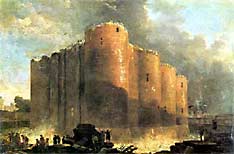
Demolition of the Bastille
La Bastille dans les premiers jours
de sa démolition (1789)
by Hubert Robert (1733-1808) |
| |
The propaganda value of the Bastille was quickly seized upon, notably by the showy entrepreneur Pierre-François Palloy, nicknamed Patriote Palloy. The fate of the Bastille was uncertain, but Palloy was quick to establish a claim, organizing a force of 500 demolition men around the site on the 15th — only a day after it had been stormed. Over the next few days many notables visited the Bastille, and it seemed to be turning into a memorial. But Palloy obtained a license for demolition from the Permanent Committee at the Hôtel de Ville and quickly took complete control.
Palloy secured a fair budget and his crew grew to around 1,000 men. He had control over all aspects of the work and the workers, even to the extent of having two of them hanged for murder. Palloy put much effort into continuing the site as a paying attraction and producing a huge range of souvenirs, selling pieces of the rubble accompanied by certificates of authenticity.
The actual demolition proceeded at a rapid pace — by November 1789 the structure was largely demolished. A significant number of its stones were recycled and used to construct the Pont de la Concorde across the Seine River (between Place de la Concorde and the Palais Bourbon, now the seat of the National Assembly).
Reconstruction of the Bastille for 1889 Exposition
| | |
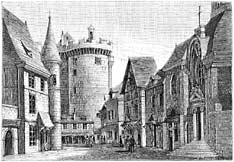
Reconstructed Bastille, 1889 Exposition
(artist unknown) |
|
| |
The Exposition of 1889, a huge affair covering some 237 acres and numbering over sixty thousand official exhibits, featured a reconstructed Bastille: customers could not only look at a huge reproduction of the gloomy fortress and the adjacent Rue Saint Antoine, but they could also go inside for banquets in the Hall of Festivities and watch a pantomine entitled "the escape of a prisoner of the Bastille" (a suspenseful adventure ending with the recapture of the prisoner).
The complex was conceived by the architect Eugène Colibert (1832-1900), a former student of Viollet-le-Duc. It was constructed at the corner of avenue Suffren and avenue de la Motte Picquet, at the edge of the Champs de Mars (near the École Militaire). The expensive project was financed by a M. Perrusson, an industrialist and manufacturer of ceramics in Saône-et-Loire. It opened a year before the Exposition itself.
Just outside the attraction, well-dressed riders on wooden horses whizzed down a roller-coaster track. This amusement-park Bastille turned the historic symbol of bitter conflict into fun and considerable profit; it amassed receipts of 538,748 francs in 1888 and 529,023 francs in 1889 — twice the amount collected by the Cirque Fernando and the Ambassadeurs.
| | |
| |
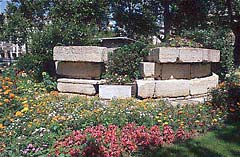
Tower of Liberty, the only remains
of the original Bastille fortress. |
| |
Surviving Remnants
Today, practically all that remains of the Bastille's structure is a pile of stones that were once part of the Tour de la Liberté (Liberty Tower), one of eight towers in the fortress. They were discovered in 1899 during tunnel excavation for Line 1 of the Paris Métropolitain (subway), under rue St-Antoine.
The pile was moved in 1900 to the tiny Square Henri Galli, about 500 meters from the original fort's location, at the intersection of Quai des Célestins and Boulevard Henri IV (near the Sully-Morland métro stop). The stones are marked with a plaque, which reads as follows:
| (original French) |
(translated) |
VESTIGES DES FONDATIONS
DE LA BASTILLE
LA TOUR DE LA LIBERTÉ
DÉCOUVERTS EN 1899
ET TRANSPORTÉS SUR CET EMPLACEMENT |
REMAINS OF THE FOUNDATIONS
OF THE BASTILLE
THE LIBERTY TOWER
DISCOVERED IN 1899
AND TRANSPORTED TO THIS LOCATION |
In the Bastille station of the Métro, on the platform for line 5 (to Pantin), there is a small exhibit of some masonry from the old fortress.
Although the original site of the Bastille is now occupied by several restaurants and other buildings, it is possible to see an outline of its old walls marked on the sidewalks and street surfaces — thanks to colored paving stones installed by the City of Paris — at the intersection of Boulevard Henry IV and Rue Saint Antoine (at the edge of Place de la Bastille).
Click here to see a map of modern-day city streets overlaid on the site of the former Bastille.
Pachyderm Curiosity
| | |
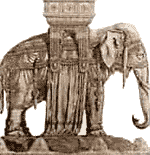
Elephant erected on
Place de la Bastille |
|
| |
Between 1813 and 1846, Parisians were treated to the sight of a larger-than-life elephant at the Place de la Bastille, very close to the location of the present opera house. (It is visible in the 1880 Hoffbauer painting, to the left of the July Column.)
The monstrosity was conceived in 1808 by Napoleon I, who envisioned giving the citizens of Paris a monument to represent the grandeur of the French Empire. He dictated that it be a fountain 24 meters high, cast in bronze from the melted-down cannons of the conquered Spanish, with water gushing forth from its snout, and a staircase in one of its legs to allow ascent to the top.
| | |
| |
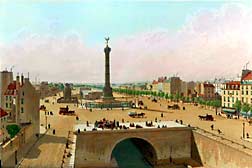
Place de la Bastille, ca. 1841
Lithograph from 1880 by F. Hoffbauer,
after an image dated 1841. |
| |
The structure was designed by architect Jean-Antoine Alavoine, working with sculptor Pierre-Charles Bridan, and a foundation was built. Eventually, five years later, the architects Charles Percier and Pierre-François Léonard Fontaine erected a mock-up of the monument — with somewhat more modest proportions: 14.6 meters high and 16.2 meters long, and composed of plaster rather than bronze.
Following Napoleon's demise, the curious monument was allowed to fall into a state of disrepair; as early as 1831, there was talk of demolishing it — though it was still guarded by a brave man named Levasseur who lived in one of its feet! Victor Hugo, in Les Misérables, made it a refuge for his character Gavroche. Apparently, the city's rats also appreciated the hospitality it afforded them: at the time of its destruction by Visconti in July 1846, thousands of the rodents escaped from its ruins and terrorized the quarter's residents for several weeks.
GO TO NEXT PAGE »
The July Column
|

